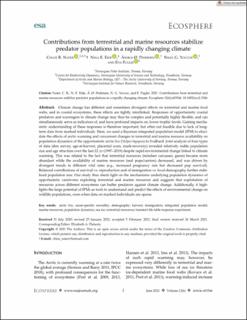| dc.contributor.author | Nater, Chloe Rebecca | |
| dc.contributor.author | Eide, Nina Elisabeth | |
| dc.contributor.author | Pedersen, Åshild Ønvik | |
| dc.contributor.author | Yoccoz, Nigel | |
| dc.contributor.author | Fuglei, Eva | |
| dc.date.accessioned | 2021-07-21T11:21:13Z | |
| dc.date.available | 2021-07-21T11:21:13Z | |
| dc.date.created | 2021-06-22T15:13:50Z | |
| dc.date.issued | 2021 | |
| dc.identifier.citation | Ecosphere. 2021, 12 (6), . | en_US |
| dc.identifier.issn | 2150-8925 | |
| dc.identifier.uri | https://hdl.handle.net/11250/2764892 | |
| dc.description.abstract | Climate change has different and sometimes divergent effects on terrestrial and marine food webs, and in coastal ecosystems, these effects are tightly interlinked. Responses of opportunistic coastal predators and scavengers to climate change may thus be complex and potentially highly flexible, and can simultaneously serve as indicators of, and have profound impacts on, lower trophic levels. Gaining mechanistic understanding of these responses is therefore important, but often not feasible due to lack of longterm data from marked individuals. Here, we used a Bayesian integrated population model (IPM) to elucidate the effects of arctic warming and concurrent changes in terrestrial and marine resource availability on population dynamics of the opportunistic arctic fox (Vulpes lagopus) in Svalbard. Joint analysis of four types of data (den survey, age-at-harvest, placental scars, mark-recovery) revealed relatively stable population size and age structure over the last 22 yr (1997–2019) despite rapid environmental change linked to climate warming. This was related to the fact that terrestrial resources (reindeer carcasses, geese) became more abundant while the availability of marine resources (seal pups/carrion) decreased, and was driven by divergent trends in different vital rates (e.g., increased pregnancy rate but decreased pup survival). Balanced contributions of survival vs. reproduction and of immigration vs. local demography further stabilized population size. Our study thus sheds light on the mechanisms underlying population dynamics of opportunistic carnivores exploiting terrestrial and marine resources and suggests that exploitation of resources across different ecosystems can buffer predators against climate change. Additionally, it highlights the large potential of IPMs as tools to understand and predict the effects of environmental change on wildlife populations, even when data on marked individuals are sparse. arctic fox; cause-specific mortality; demography; harvest; immigration; integrated population model; marine resources; population dynamics; sea ice; terrestrial resources; transient life table response experiment | en_US |
| dc.language.iso | eng | en_US |
| dc.publisher | Ecological Society of America, ESA | en_US |
| dc.rights | Navngivelse 4.0 Internasjonal | * |
| dc.rights.uri | http://creativecommons.org/licenses/by/4.0/deed.no | * |
| dc.subject | Fjellrev | en_US |
| dc.subject | Arctic fox | en_US |
| dc.title | Contributions from terrestrial and marine resources stabilize predator populations in a rapidly changing climate | en_US |
| dc.type | Peer reviewed | en_US |
| dc.type | Journal article | en_US |
| dc.description.version | publishedVersion | en_US |
| dc.subject.nsi | VDP::Zoologiske og botaniske fag: 480 | en_US |
| dc.subject.nsi | VDP::Zoology and botany: 480 | en_US |
| dc.source.volume | 12 | en_US |
| dc.source.journal | Ecosphere | en_US |
| dc.source.issue | 6 | en_US |
| dc.identifier.doi | https://doi.org/10.1002/ecs2.3546 | |
| dc.identifier.cristin | 1917755 | |
| dc.relation.project | Norges forskningsråd: 244647 | en_US |
| dc.relation.project | Andre: NMBU | en_US |
| dc.relation.project | Andre: Climate-Ecological Observatory for Arctic Tundra (COAT) | en_US |
| dc.relation.project | Andre: Norwegian Ministry of Environment | en_US |
| dc.relation.project | Andre: Norwegian Polar Institute | en_US |
| dc.description.localcode | Open Access CC-BY | en_US |
| cristin.ispublished | true | |
| cristin.fulltext | original | |
| cristin.qualitycode | 1 | |

